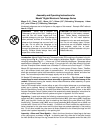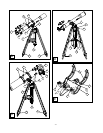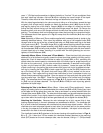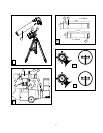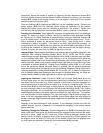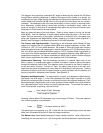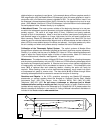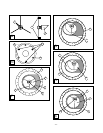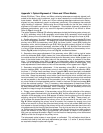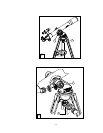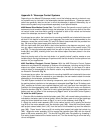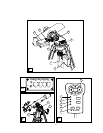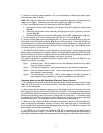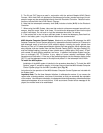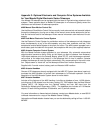
Appendix 1: Optical Alignment of 114mm and 127mm Models
Meade DS 60mm, 70mm, 80mm, and 90mm refracting telescopes are optically aligned (colli-
mated) at the factory prior to shipment, and it is never necessary to re-collimate the optics of
these models. Meade DS 114mm and 127mm reflecting telescope models are also factory-
aligned, but may occasionally require re-alignment, particularly if the telescope has received
rough handling in shipment. Before using one of these models for the first time, check the
alignment of the optics as outlined in this appendix. Good optical alignment is essential for
telescope performance, and in any case the alignment procedure is not difficult to follow.
Refer to Figs. L through S:
The optical systems of Meade DS reflecting telescopes include the following parts: primary mir-
ror (L-1); secondary mirror (L-2); secondary mirror-holder (L-3); secondary mirror-vanes (L-4
and M1); primary mirror-tilt screws (L-5). The telescope’s image is brought to a focus at (L-6).
1. Confirm alignment: To confirm optical alignment look down the focuser drawtube (C-11 and
P-1) with the eyepiece removed. The edge of the focuser drawtube frames reflections of the
primary mirror (P-2), the secondary mirror (P-3), the three (“spider”) vanes (P-4) holding the
secondary mirror, and the observer’s eye (P-5). With the optics properly aligned, all of these
reflections appear concentric (centered), as shown in Fig. P. Any deviation from concentrici-
ty of any of these telescope parts with the eye requires adjustments to the secondary mirror-
holder (Fig. M) and/or the primary mirror cell (Fig. N), as described below.
2. Secondary mirror-vane adjustments: If the secondary mirror (Q-1) is left or right of center
within the drawtube (Q-2), slightly loosen the 3-vane adjustment/lock knobs (M-1) located on
the outside surface of the main tube and slide the entire secondary mirror-holder system up or
down in the slotted holes of the main tube until the secondary mirror is centered in the draw-
tube. If the secondary mirror (Q-1) is above- or below-center within the drawtube, thread
inward one of the adjustment/lock knobs (M-1) while unthreading another of these knobs. Only
make adjustments to two knobs at a time until the secondary mirror appears as in Fig. R.
3. Secondary mirror-holder adjustments: If the secondary mirror (R-1) is centered in the
focuser drawtube (R-2), but the primary mirror is only partially visible in the reflection (R-3),
the three “+” (Phillips head) secondary mirror-tilt screws (M-2) should be slightly unthreaded
to the point where the secondary mirror-holder (M-3) can rotate about its axis parallel to the
main tube. Grasp the secondary mirror-holder (avoid touching the mirror surface!) with your
hand and rotate it until, looking through the drawtube, you can see the primary mirror centered
as well as possible in the reflection of the secondary mirror. With the rotation of the second-
ary mirror-holder at this best-possible position, thread in the three Phillips-head screws (M-2)
to lock the rotational position. Then, if necessary, make adjustments to these three Phillips-
head screws to refine the tilt-angle of the secondary mirror, until the entire primary mirror can
be seen centered within the secondary mirror’s reflection. With the secondary mirror thus
aligned the image through the drawtube appears as in Fig. S.
4. Primary mirror adjustments: If the secondary mirror (S-1) and the reflection of the primary
mirror (S-2) appear centered within the drawtube (S-3), but the reflection of your eye and the
reflection of the secondary mirror (S-4) appear off-center, then the primary mirror-tilt requires
adjusting, using the Phillips-head screws of the primary mirror cell (N-3). These primary mir-
ror-tilt screws are located behind the primary mirror, at the lower end of the main tube. See
Fig. N. Before adjusting the primary mirror-tilt screws, first unscrew by several turns (use
either a hex wrench or pliers) the three hex-head primary mirror lock screws (N-2) which are
also located on the rear surface of the primary mirror cell and which alternate around the cell’s
circumference with the three Phillips-head screws. Then by trial and error turn the primary mir-
ror Phillips-head tilt screws (N-3) until you develop a feel for which way to turn each screw to
center the reflection of your eye in the drawtube. (An assistant is helpful in this operation.)
With your eye centered as shown in Fig. P, turn the three hex head primary mirror lock screws
(N-2) to re-lock the tilt-angle of the primary mirror.
The telescope’s optical system is now aligned, or collimated. This collimation should be re-
checked from time to time, with small adjustments (per steps 1, 2, and/or 3, above) effected
as required to keep the optics well-aligned.
- 13 -



